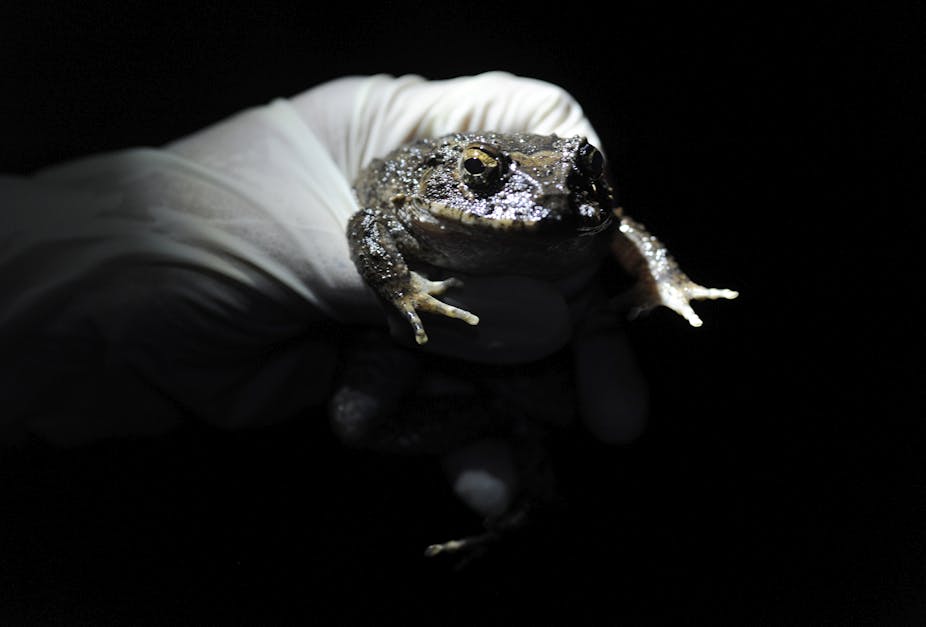The threat of diseases moving from animals to people has been the focus of many studies and is well documented in public and scientific communications. 60% of infectious diseases in humans have been estimated to come from animals. Nevertheless we need to be concerned about the threat that people present to the health of animals.
According to the Centers for Disease Control and Prevention, the health of humans is connected to the health of animals and the environment. This approach is known as the One Health concept.
A recent study suggests animals that have been domesticated for longer periods of time are more likely to share their diseases with humans. And we’ve witnessed the devastating diseases that have emerged from wildlife hosts to affect humans – including the Ebola virus, Hantavirus, SARS, and human immunodeficiency virus (HIV). Yet the impact that the increasing presence of humans and domestic animals in previously pristine habitats has on wildlife is under-reported.
People spread diseases unintentionally
Pathogens usually co-evolve with their hosts. This means they reach a balance within a population so that a species will develop defences resulting in co-existence of pathogen and host. But when new interfaces between species occur or there is a disturbance in the ecosystem, this balance may be upset. This results in increased vulnerability to emerging diseases.
An example of this is in chytrid fungus (Bactrachochytrium dendrobatidis) that causes a lethal skin disease to amphibian populations globally. Some species, like American bullfrogs and African clawed frogs, are resistant to the fungus. The accidental or intentional movement of these animals may lead to the introduction of the disease to naïve frog populations.
In the case of some frog species there are a number of human factors which have led to the spread of the disease. These factors have also contributed to the extinctions of some populations. The factors include: global trade in pet and laboratory amphibians, habitat destruction, and the transfer of fungus on equipment and boots of people entering habitats.
People have moved their livestock and pets for centuries. This is not a new phenomenon, as diseases have been introduced to native peoples and wildlife during the European exploration of the New World, the colonisation of Africa, and the establishment of trade routes to the Far East.
The diseases that are spread
Humans are reservoirs of many diseases. They have an impact on diseases in wildlife through direct interaction as well as indirect activities.
Direct interaction with wild animals include ecotourism, bushmeat hunting, research, and the movement of pets – which carries a risk of disease spread in both directions.
Endangered gorillas live in the mountains of Rwanda, Uganda, and the Democratic Republic of the Congo. They are surrounded by some of the densest human communities in Africa. As a result there has been regular contact between these animals and humans because of: habituation, gorilla movement, human encroachment and beneficial research programs. This has brought these animals into close proximity with people and their pathogens.

As a result, respiratory infections and parasites have spread. Disease outbreaks and fatalities have been recorded in gorillas due to measles and bacterial pneumonia. We’ve also seen poliomyelitis and measles in wild chimpanzees in Tanzania.
Human tuberculosis (TB), caused by Mycobacteria tuberculosis, is another disease which affects a wide variety of wild animals, including chimpanzees, elephants and rhinoceros.
Although most cases have occurred in captivity, the increased contact between wildlife and humans in these settings presents a risk to animal health. There is also a disease risk in semi-captive situations where animals may also interact with their wild counterparts, especially in countries with a high rate of TB like Nepal.
Human TB has been recognised as the cause of deaths in working elephants in Nepal. Awareness has allowed implementation of programs to prevent spread from humans to elephants and minimise the impact of the disease on the elephants.
Bovine tuberculosis caused by Mycobacterium bovis in cattle was initially recognised in South Africa in 1880, where it is considered an alien disease. By 1928, the first cases were identified in a greater kudu and common duiker. In less than 100 years, this disease has been found in more than 21 different wildlife species in South Africa.
Bovine tuberculosis has also become established in other populations worldwide. These include badgers and wild boars in Europe, deer in North America, and brush-tailed possums in New Zealand.
Indirect activities stem from human development in previously pristine habitats, global travel and climate change. This too has resulted in the increased risk of disease transmission through indirect activities. For example, the human protozoal parasite, Giardia duodenalis, has been found in the endangered African wild dogs, mountain gorillas, and beavers. It is believed that people contaminate the environment, resulting in exposure of animals through sewage runoff.
Other less apparent indirect impacts caused by humans include movement or expansion of geographical boundaries for disease vectors such as mosquitoes. The West Nile Virus was introduced to the US in 1999, probably as a result of movement of an infected bird or mosquitoes, or possibly travel of an infected human.
Since that time, massive mortalities have occurred in wild birds, and other native and non-native wildlife in the US. There has also been serious health consequences for horses and humans.
Increased knowledge is needed to understand the role that humans play in diseases of domestic and wild animals. We may contribute to emerging diseases through climate change, habitat use, global and local movements of species, and interactions with animals and their environment. We need to understand better how to mitigate the effects of disease on our wildlife.

